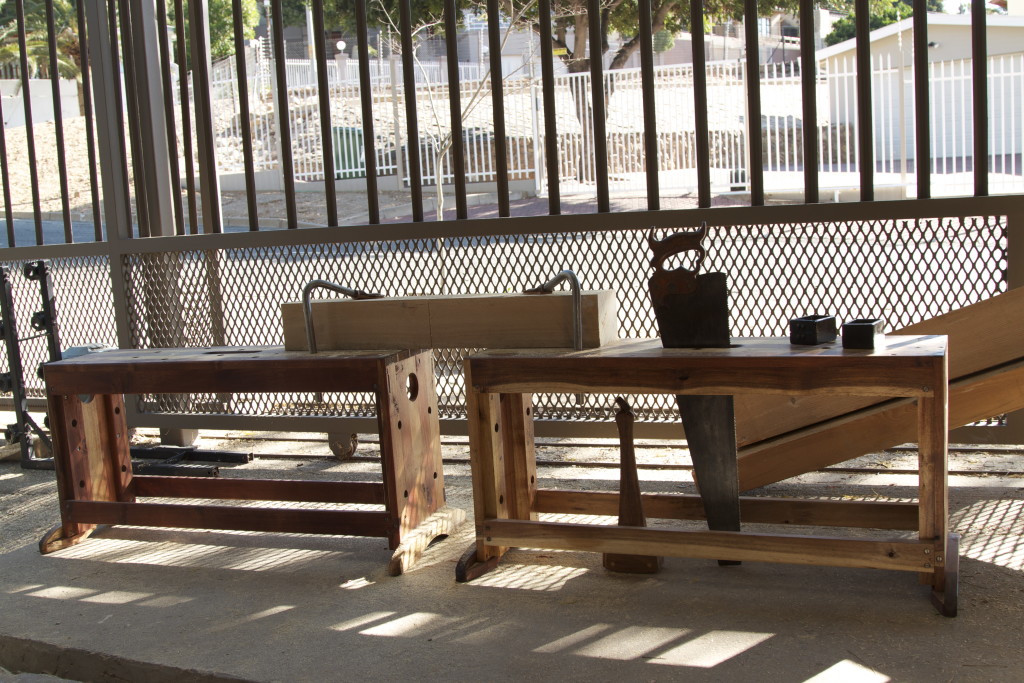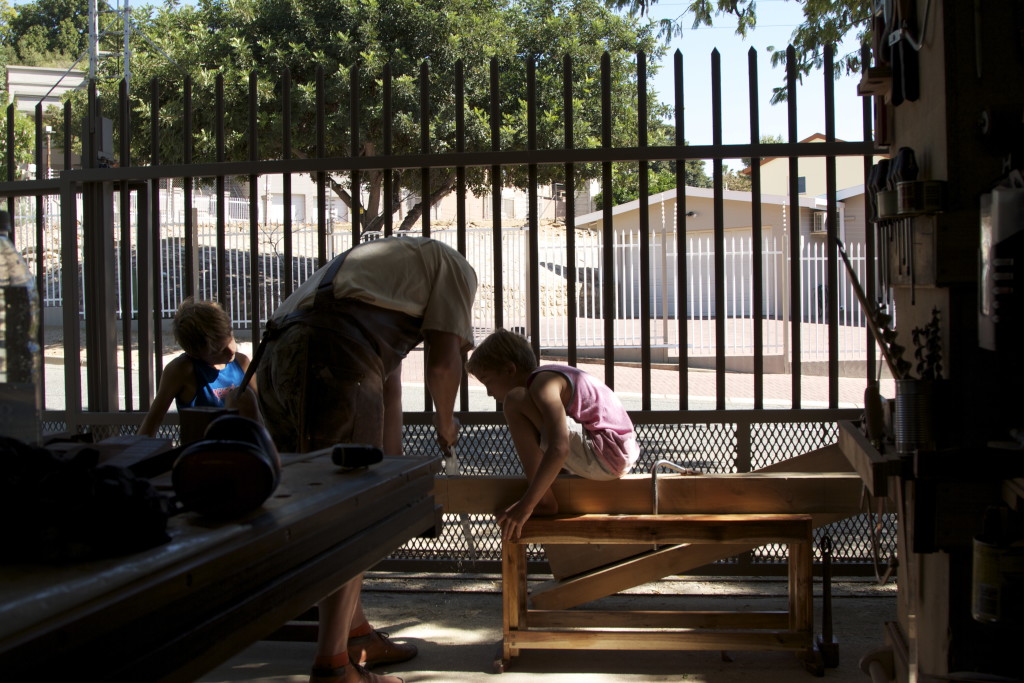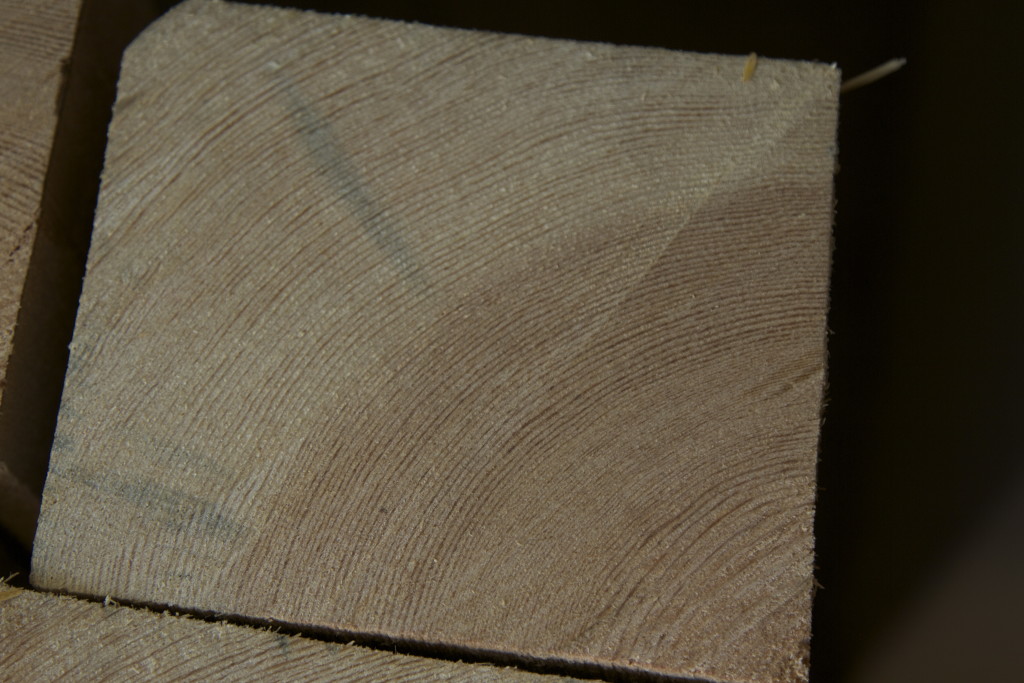1/6/2015
I’ve been planning to build a small sharpening station in order to make it easier to keep all my edge tools in top nick. At the moment I have to dig out the sharpening paraphernalia, set it up, sharpen what ever needs attention and pack it all away. This has the side effect of postponing one of the most important tasks of a hand tool woodworker.
Since stumbling across a very nice stash of wood I’ve realised that I could fit a 3.2 meter (length) by 600 mm (width) bench up against one wall of my shop. The dimensions of the wood would also allow for such a bench. The idea is that I might as well build a big bench and it could double up as a stand for my drill press, bench grinder, the green monster and a dedicated sharpening station.
I enjoyed using the Roubo joinery for my current workbench so much that it was an obvious choice for this bench.
As this is reclaimed wood, my team of keen apprentices had to do quite a bit of cleaning before we could removed all the nails carefully.
Once that was done, I used one of my favourite tools to chop up these beautiful beams for the legs, aprons, and stretchers. It is of course my 24″ Disston no. 12 (7ppi crosscut) saw that dates back to 1896. It is an absolute gem of a tool. It is mind boggling how a tool of this quality could have been mass produced. The pictures (above and below) also show how useful a set of saw benches can be in conjunction with holdfasts for this type of work.
This is definitely the best pine I have ever worked with. Can anyone out there identify the species from these photos, I have no idea?
I then removed wind and squared up two reference faces before feeding the legs to the electric planer. My shop made fore plane and scrub plane (which was used as a super aggressive fore plane in this case) made short work of this job. I must say it was a pleasant surprise to realise how easy it can be to plane wood like this after years of planing African hard woods. I am starting to realise that I have been a “metal” worker up until now, if this is how it feels to work wood.
This is what the legs looked like just before it went through the planer.
After the planer munched on it, it looked like this. You can see how I marked out the famous Roubo through tenons. In the process of sawing these I discovered a very handy design advantage of my sliding deadman. The pictures show how the leg sat comfortably and stable at the correct angle for the sawing between two dogs.
The next step was to drill out material as illustrated with a spade bit. The rest was removed with my shop made bow saw in order to free up the waste between the tenons. The shoulders were sawn using the setup as shown.
I had to fetch another beam for the stretchers and my Cruiser was at the garage. The only option was to use the small delivery car of my practice. Luckily it is only a few blocks away. As you can see, I used my newly built Roubo bow saw to chop off the length that was required. I ripped this piece down the middle (on the band saw) to created the two long stretchers. In order to plane them I had to use the whole length of my bench, which necessitated an improvised planing stop. The pictures tells the story.







































Interesting, I too have a sharpening station in the plans. Curious to see how yours turns out. You are right, having a dedicated sharpening set up ready to go is quite a boon to us hand tool woodworkers.
Quite an enthusiastic crew of assistant you got there 🙂 Its good to see the young ones taking an interest in woodworking. It will serve them good later.
Regards
Bob
Hi Bob
Thank you for your comment. Yes my team is very enthusiastic, albeit for fairly brief spells at a time. I try not to force the issue, because that would only drive them away. The boy with the bright orange shirt is my son’s best mate, Connor. He is clearly a woodworker for the future. He sometime helps me in the shop while my son is kicking a ball in the backyard.
This will really only be a standard Roubo shaped bench on which I will dedicate an area to all the sharpening paraphernalia.
Thanks again for your comment it is much appreciated.
Gerhard
Hi Gerhard,
this wood is without doubt what the english call “scotts pine” and what we just call “Kiefer”; being “Pinus sylvestris”.
The sapwood sometimes gets blue streaks, as one cross-section shows; this does not mean any mechanical weakness, it’s just cosmetics. OK, it is a fungus, but it does no harm at all.
You where lucky to get wood of this quality; all the engines, parts and fittings we get here on the shipyard are packed in crates of spruce with cm-wide growthrings.
I love the smell of this pine, especially as you cut a knot…
Enjoy,
Carsten
Hi Carsten
Thank you for your comment. In fact it is one of the most valueble contributions anyone has made to this site. You are quite right about the fungus streeks, I saw several while working with this wood. I also agree on it’s effect on the wood, it does nothing apart from improving the aesthetics. A lot of my stash of African hard woods have the same thing. Thanks for confirming that it is quality wood, it makes this project so much more meaningful. I am not sure wether you saw in a previous post, but this wood to the best of my knowledge comes from Germany where it seems you hail from.
Thanks again for this very valueble information.
Gerhard
Carsten
I forgot to add that you were spot on with regards to the smell too, it is superb!
Cheers mate.
Looking forward to the build, and looks like you’ve quite a helpful crew there 🙂
Thanks Siavosh, when are you coming on your Namibian Safari? Let me know.
Cheers
Gerhard
Wow, Gerhard,
That’s quite the small army of helpers that you have going there. Your pizza bill must be on the rise. I’m looking forward to seeing how this bench comes together, you are moving along quickly already.
Jonathan
Jonathan
Over the past weekend the wife was at the coast so I fed them the Namibian diet, which consists of meat cooked on the open fire. No plants are allowed in this diet. Around these parts people usually refer to chicken as a vegetable and often say things like “the cattle ate plants, therefore meat is concentrated vegetables, so I do eat vegetables, only in a different form”. It is a very convenient diet while the wife is away and it clearly helps the team to work like slaves.
Thanks for your comment.
Gerhard